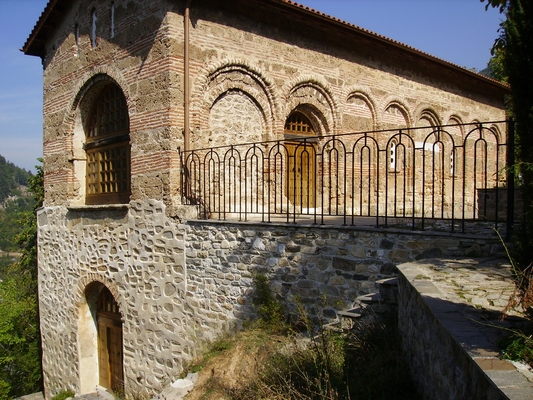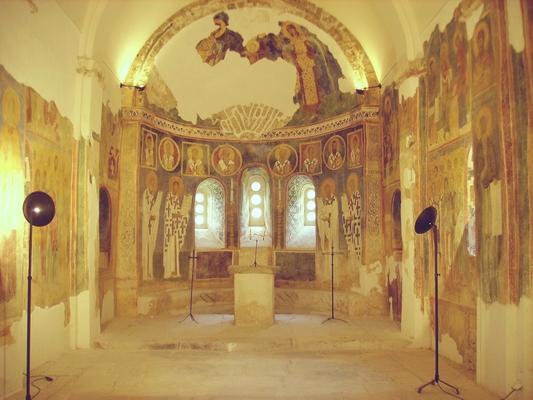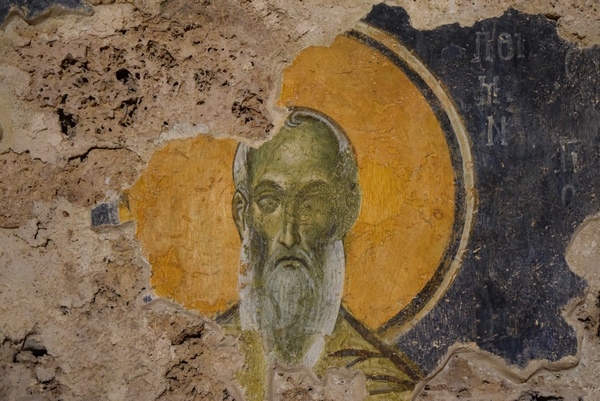Monastery Ossuary
In the architecture of the building, we discover contemporary Bulgarian and Byzantine influences, as well as Syrian and Caucasian. The church is a rectangular basilica, with narthexes on both floors, which in the beginning, had been open galleries. The facade is made of greatly decorated arches, divided by built in semi-colons.

The ossuary is the only one with preserved frescoes in the orthodox world. Some date to the XIth century, others to the XIVth century. The painter, Joan Iveropulec, has left those masterpieces of the early Christian art. Pastel tones wrap the saint and church scenes on the walls; impress us with anchoretic peace and disarming convincingness.
The first floor is homage to the bones of the monks to the day of Resurrection and the Day of Judgement. On the walls around the narthex, we can see presented a scene of Last Jugement and this of ‘Divulgation of the dead’, right above the entrance. In the details, one can witness the return of bodies to sea, Earth, the graves. In the central nave up of the door, too, there is a scene from the composition ‘Vision of prophet Ezekiel from the field of dry bones’. At the altar, one can see a ‘deisis’ or the intercession of the Holy Virgin and Joan the Baptist for Jesus for us the sinners in the time of Judgement Day. Particular impression makes the image of the Holy Virgin, stoical in portrayal, one of the genius achievements of Christian art.
In this narthex, one can also see four portraits of the founders: donors Gabriel and George from the XIV century, and the founders of the monastery Grigorii and Abasii Bakuriani.
The second floor does have better preserved frescoes, once again by Joan Iveropulec. In the narthex of this floor, there is a portrait of Joan Alexander, the king of Bulgaria in the time, of St. Konstantin and St.Elena, and of Joan the Evangelist. The king is drawn in full height; there is an inscription above his head: ‘In the glory of Christ, pious king and autocrat of Bulgarians and greeks’. The image of Joan the Evangelist, holy patron of the king, makes an impression with the fine draftsmanship of the head.
The inside part of the church was decorated with scenes from the life of Jesus Christ. From the south side, one can see well preserved ‘The Presentation in the Temple’, ‘Baptizing of Jesus’ and ‘Resurrection of Lazar’, on the north follow less preserved ‘Palm Sunday’, ‘Lamentation of Christ’ and ‘Women with myrrh visit the grave of Jesus’
In the open space of the altar, painted in two scenes lies the communion of the apostles and the apse is decorated with ‘The Virgins with Archangels’. On the first level of the wall, next to the place where the chancel used to be, in two groups, there is a depiction of All Saints, most probably patron of the temple.
At present, the ossuary is a museum.
Inquire inside the monastery for visitation.


Support us
The monastic fraternity constantly makes every endeavor to maintain the Cloister of the Holy Virgin at its best condition; this is the condition the cloister really deserves to be in, in order to welcome the thousands of pilgrims that visit it every year, truly beautifully and impress them.
The maintenance of the fund and the restoration of the many unique frescoes, inherited by the holy forefathers, could be quite costly and the monastery does not always manage to cover all the expenses. For this very reason, we turn for help to every Christian and to everyone who values the Bachkovo monastery, to contribute within their means and thus join our efforts.
Every charitable deed will be welcomed with honest gratitude and intercessory prayer in the name of Jesus Christ and the Holy Mother for wellbeing and success of the contributor and their family.
BANK ACCOUNT
in LEVA
DSK Bank
Assenovgrad/Bulgaria
BG87STSA93000006966034
STSABGSF
in EURO
DSK Bank
Assenovgrad/Bulgaria
BG93STSA93000022259722
STSABGSF



